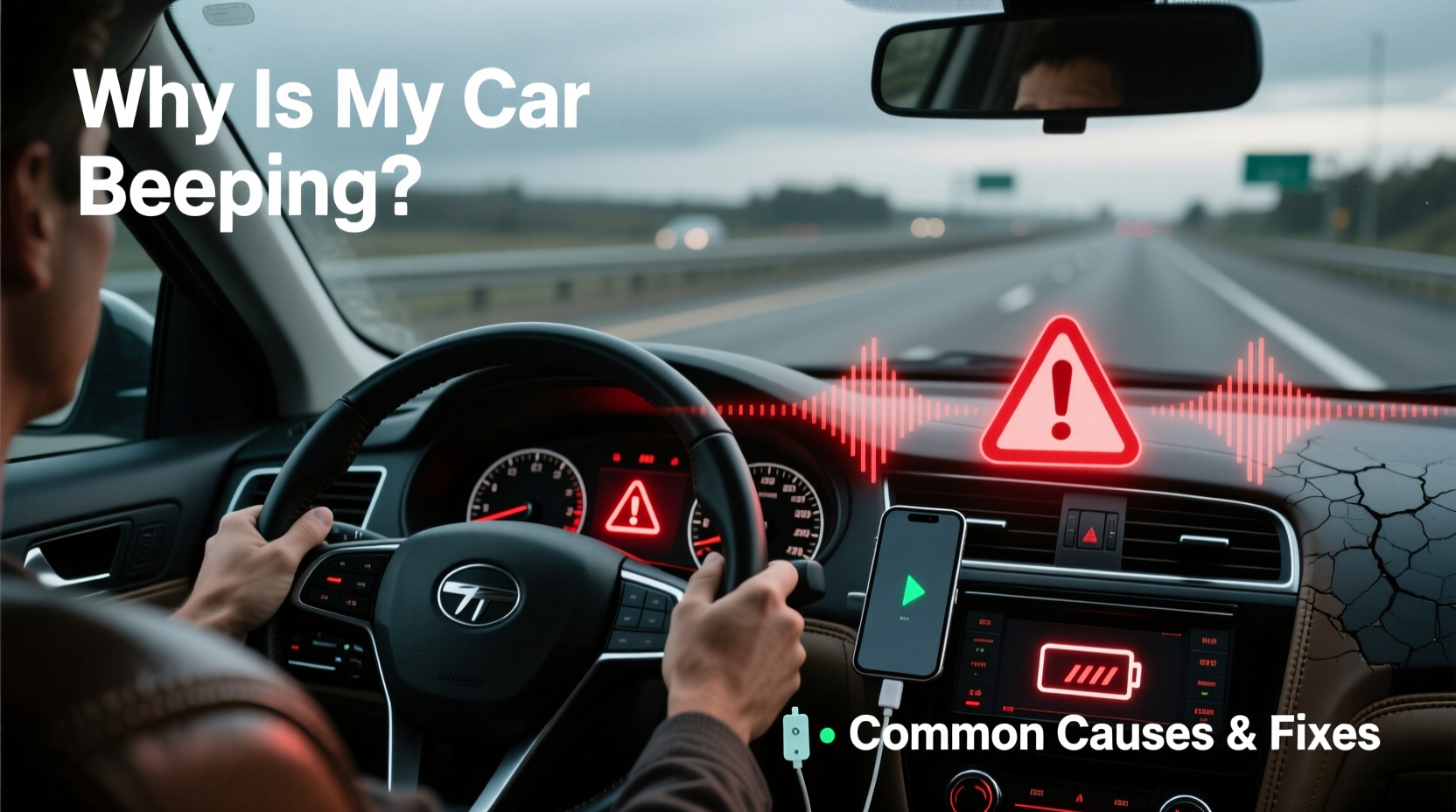A sudden or persistent beep while driving can be more than just a nuisance—it’s often your vehicle’s way of communicating an issue. Unlike warning lights, which are visual cues, audible alerts demand immediate attention because they’re designed to break through distractions. Understanding the meaning behind these sounds is essential for safety, preventing costly repairs, and maintaining confidence on the road. Modern vehicles are equipped with dozens of sensors and monitoring systems, each capable of triggering a beep under specific conditions. Some alerts are routine, such as reminding you to fasten your seatbelt, while others may indicate serious mechanical or electrical problems.
This guide breaks down the most common reasons your car might beep while driving, offers actionable troubleshooting steps, and helps you distinguish between minor alerts and critical warnings that require professional attention.
Common Causes of Beeping While Driving

Car manufacturers use auditory signals to alert drivers to various issues. The pattern, frequency, and timing of the beep often provide clues about its origin. Below are the most frequent causes:
- Seatbelt Reminder: A repetitive chime occurs if the driver or passenger hasn’t fastened their seatbelt within seconds of starting the engine.
- Open Door or Trunk: A continuous or intermittent beep indicates that a door, hood, or trunk isn’t fully closed.
- Low Fuel Warning: A series of beeps may sound when fuel levels drop below a critical threshold.
- Key Left in Ignition: If the key remains in the ignition after turning off the engine and opening the door, many cars emit a warning tone.
- Lights-On Reminder: A single-tone beep when exiting the vehicle warns that headlights or parking lights are still on.
- Advanced Driver Assistance Systems (ADAS): Lane departure warnings, blind-spot detection, forward collision alerts, and parking sensors all use beeps to signal potential hazards.
- Low Tire Pressure: While usually indicated by a dashboard light, some models accompany it with an audible alert.
- Electrical or System Malfunctions: Issues with the battery, alternator, brake system, or onboard computer may trigger beeping patterns unique to the fault.
Troubleshooting Steps for Persistent Beeping
When your car beeps unexpectedly during operation, follow this logical sequence to diagnose and resolve the issue:
- Check Immediate Safety Concerns: Ensure all doors are closed, seatbelts are fastened, and no warning lights are illuminated on the dash.
- Review Recent Actions: Did you just refuel? Install new tires? Use cruise control? These actions can temporarily trigger alerts.
- Inspect Dashboard Indicators: Match the beep with any active warning symbols—ABS, check engine, TPMS, etc.
- Test Drive Conditions: Does the beep occur at certain speeds? When braking? During turns? This can point to sensor-related ADAS alerts.
- Restart the Vehicle: Turn off the engine completely and restart. Some transient glitches reset after a power cycle.
- Consult the Owner’s Manual: Look up the specific beep description. Most manuals include a section on audible warnings and their meanings.
“Modern vehicles generate over 20 different chimes, each with a distinct purpose. Misinterpreting them can lead to ignored critical warnings.” — James Rutherford, Automotive Diagnostics Technician
Do’s and Don’ts When Dealing With Car Beeps
| Do’s | Don’ts |
|---|---|
| Refer to the owner’s manual for beep interpretations | Ignore repeated or urgent-sounding beeps |
| Inspect physical components like doors, belts, and lights | Disconnect the battery without diagnosis (can erase ECU memory) |
| Use an OBD2 scanner for error codes if the check engine light is on | Disable safety alerts permanently (e.g., seatbelt chime) unless legally permitted |
| Visit a mechanic if the cause isn’t obvious after basic checks | Assume all beeps are false alarms |
Real-World Example: Diagnosing a Mysterious Highway Beep
Sarah, a daily commuter in Colorado, began hearing a short double-beep every time she exceeded 65 mph on the highway. It didn’t trigger any dashboard lights, so she initially dismissed it. After several days, the frequency increased. She consulted her manual and discovered the sound matched the lane departure warning (LDW) system. A quick test confirmed the beep only occurred when drifting near lane markings without signaling. A visit to her service center revealed the front camera—mounted near the rearview mirror—was slightly misaligned due to recent windshield cleaning with a rough squeegee. After recalibration, the false alerts stopped. This case highlights how ADAS features can malfunction due to minor physical disruptions and underscores the importance of not ignoring consistent but non-critical alerts.
Step-by-Step Guide to Resetting or Disabling Non-Critical Alerts
Some beeps, like seatbelt reminders, can become overly aggressive. While not recommended for safety reasons, certain vehicles allow limited customization. Follow these steps cautiously:
- Turn the ignition to “ON” without starting the engine.
- Fasten and unfasten the seatbelt three times within five seconds.
- Observe the seatbelt warning light—if it flashes slowly, the system may enter programming mode.
- Press and hold the odometer reset button (if equipped) until the chime changes or stops.
- Turn off the ignition. Wait 30 seconds before restarting.
Note: This method varies significantly by make and model. Consult your manual before attempting. Permanent disabling may violate local safety regulations and void warranties.
Frequently Asked Questions
Why does my car beep even though everything seems fine?
Occasionally, sensors can send false signals due to dirt, moisture, or temporary electrical noise. A glitchy door sensor or misaligned ADAS camera can trigger phantom alerts. If the beep persists, have the system scanned for diagnostic trouble codes (DTCs).
Can low battery cause random beeping?
Yes. A weak or failing battery can disrupt the voltage supply to control modules, leading to erratic behavior including unexpected chimes. If your car struggles to start or accessories behave oddly, battery testing is advised.
Is it safe to drive if my car keeps beeping?
It depends. If the beep is accompanied by a red warning light (e.g., oil pressure, brake system), pull over safely and stop driving. For yellow/orange lights or isolated chimes without other symptoms, proceed with caution and schedule a diagnostic check promptly.
Conclusion: Stay Alert, Stay Safe
Your car’s beeping system is a vital part of its communication network. Rather than viewing it as an annoyance, treat each alert as valuable feedback. Most beeps serve a protective function, helping prevent accidents, breakdowns, or long-term damage. By understanding the common causes, applying structured troubleshooting, and knowing when to seek expert help, you maintain not only your vehicle’s reliability but also your peace of mind on the road.









 浙公网安备
33010002000092号
浙公网安备
33010002000092号 浙B2-20120091-4
浙B2-20120091-4
Comments
No comments yet. Why don't you start the discussion?